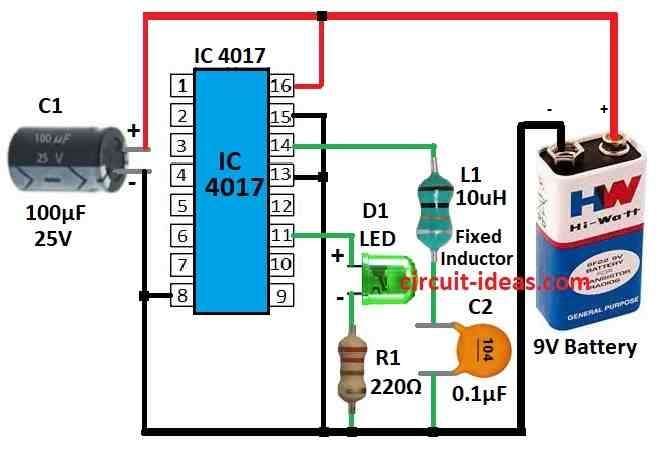In this post we will see how to make Simple Contactless 220V Phase Detector Circuit using IC 4017
This small tool help to check wire or cable if current is inside or not without touching it.
Very useful for electrician to find problem in big electric system.
If current is there in wire the light will glow by indicating it with an LED.
Circuit Working:

Parts List:
| Component Type | Description | Quantity |
|---|---|---|
| Resistor | 220Ω 1/4 watt | 1 |
| Capacitors | Ceramic 0.1µF | 1 |
| Electrolytic 100µF 25V | 1 | |
| Semiconductors | IC 4017 | 1 |
| LED Green 5mm 20mA | 1 | |
| Fixed Inductor 10uH | 1 | |
| Battery 9V | 1 |
This circuit can find AC power in wire from one foot away it can sense AC signal (hum) near power wire and shows it by turning ON the LED.
The IC used is CD4017 is a counter chip with 10 outputs.
Pin 14 of this IC is very sensitive it gets signal (e.m.f) and makes output pins high one by one.
But IC works only when pin 15 is connected to ground.
In this circuit we have used only pin 11 to glow LED.
Coil L1 takes signal from power wire and sends it to IC and then IC makes LED blink fast.
To use it just keep the circuit near the power wire and there is no need to change anything.
If LED turns ON it means wire has current.
If LED stays OFF then there is no current in wire.
Formulas:
This circuit counts the pulses from a voltage divider connected to 220V AC using CD4017 chip.
The voltage divider makes high AC voltage low which is safe for the IC.
The CD4017 gets pulses from both up and down swings of AC power.
By counting these pulse the circuit can tell the phase of AC voltage.
Capacitor Reactance:
The capacitor C2 in the circuit changes the shape of the pulse that CD4017 sees and this is called reactance.
One can find the value of reactance using this formula:
XC = 1 / (2 × π × f × C)
where,
- XC is reactance in ohms
- π is about 3.14
- f is frequency of AC from 50Hz or 60Hz
- C is value of capacitor in this circuit which is 0.1uF
Resonance Frequency:
To find the frequency where capacitor and inductor work together in LC circuit we can use this formula:
f = 1 / (2 × π × √(L × C))
where,
- f is frequency in hertz (Hz)
- L is inductance in henrys which is the value of L1
- C is capacitance in farads the value of C1
Note:
The L1 coil in this circuit does not need to be exact.
It mainly limits big current and works as a filter.
The value of L1 is usually chosen by size, cost or how much current it can handle is not by any strict formula.
How to Build:
To build a Simple contactless 220V Phase Detector Circuit follow the below mentioned assembling steps:
- Put IC CD4017 on breadboard or PCB.
- Connect pin 16 VDD to positive of power and connect pin 8 to ground .
- Take LED connect long leg anode to pin 11 of IC using 220 ohm resistor and short leg cathode goes to ground.
- One side of L1 connect to power wire of device and the other side connect to pin 14 of IC.
- Also connect pin 13 and pin 15 to ground.
- Give power to the circuit and be sure the voltage is correct for parts one uses.
- Now bring this circuit near power wire.
- If all is ok then LED will turn ON when AC current is inside the wire.
- If LED does not glow then check all wires and parts again.
Adjustments:
- If LED does not work well we can adjust to get better result.
Note:
- Be careful! This circuit works near high voltage AC.
- If anyone does not know about electronics well take help from someone who does.
Conclusion:
This Simple Contactless 220V Phase Detector Circuit using IC 4017 is simple and useful.
It can find AC voltage in wire or cable without touching it.
Very helpful for checking and finding live wires in home or office wiring.
It gives safe and easy way to know if AC voltage is present in them.
Leave a Reply